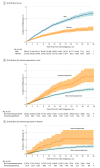Nationwide Incidence of Metastatic Cutaneous Squamous Cell Carcinoma in England
- PMID: 30484823
- PMCID: PMC6521686
- DOI: 10.1001/jamadermatol.2018.4219
Nationwide Incidence of Metastatic Cutaneous Squamous Cell Carcinoma in England
Abstract
Importance: Cutaneous squamous cell carcinoma (cSCC) is the most common skin cancer with metastatic potential, but epidemiologic data are poor. Changes to the National Cancer Registration and Analysis Service (NCRAS) in England have allowed more accurate data analysis of primary and metastatic cSCC since 2013.
Objective: To assess the national incidence of cSCC and metastatic cSCC (mcSCC) in England from 2013 through 2015.
Design, setting, and participants: This national population-based study identified a cohort of patients with cSCC and mcSCC in England from January 1, 2013, through December 31, 2015. Patients were identified using diagnostic codes derived from pathology reports in the NCRAS. Data were analyzed from March 1, 2017, through March 1, 2018.
Main outcomes and measures: Incidence rates across sex and risk factors for cSCC were derived from the NCRAS data. Risk of occurrence of mcSCC among the population with cSCC was assessed with Cox proportional hazards regression analysis to determine indicators of mcSCC.
Results: Among the 76 977 patients with first primary cSCC in 2013 through 2015 (62.7% male; median age, 80 years [interquartile range, 72-86 years]), the age-standardized rates for the first registered cSCC in England from 2013 through 2015 were 77.3 per 100 000 person-years (PY) (95% CI, 76.6-78.0) in male patients and 34.1 per 100 000 PY (95% CI, 33.7-34.5) in female patients. Increased primary cSCC tumor count was observed in older, white male patients in lower deprivation quintiles. After a maximum follow-up of 36 months, cumulative incidence of mcSCC developed in 1.1% of women and 2.4% of men with a primary cSCC. Significant increases in the risk of metastasis with adjusted hazard rates of approximately 2.00 were observed in patients who were aged 80 to 89 years (hazard ratio [HR], 1.23; 95% CI, 1.07-1.43), 90 years or older (HR, 1.35; 95% CI, 1.09-1.66), male (HR, 1.79; 95% CI, 1.52-2.10), immunosuppressed (HR, 1.99; 95% CI, 1.64-2.42), and in higher deprivation quintiles (HR for highest quintile, 1.64; 95% CI, 1.35-2.00). Primary cSCC located on the ear (HR, 1.70; 95% CI, 1.42-2.03) and lip (HR, 1.85; 95% CI, 1.29-2.63) were at highest risk of metastasis.
Conclusions and relevance: This study presents the first national study of the incidence of mcSCC. With limited health care resources and an aging population, accurate epidemiologic data are essential for informing future health care planning, identifying high-risk patients, and evaluating skin cancer prevention policies.
Conflict of interest statement
Figures

References
-
- Trakatelli M, Ulrich C, del Marmol V, Euvrard S, Stockfleth E, Abeni D. Epidemiology of nonmelanoma skin cancer (NMSC) in Europe: accurate and comparable data are needed for effective public health monitoring and interventions [published correction appears in Br J Dermatol. 2007;157(3):634]. Br J Dermatol. 2007;156(suppl 3):1-7. doi:10.1111/j.1365-2133.2007.07861.x - DOI - PubMed
Publication types
MeSH terms
Grants and funding
LinkOut - more resources
Full Text Sources
Other Literature Sources
Medical

